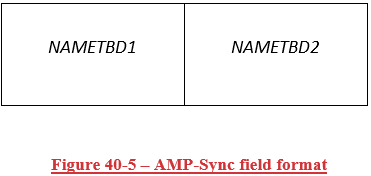Hi,Alice,
Thanks for you careful check.
For you first comment, we have already differentiate the 2 data rates with W and W_bar. As I highlighted in below.
For 250kbps data rate, the
NAMETBD1 is constructed by the 32-bit sequence
W, where each bit in the sequence is mapped to an OOK symbol of duration
2 µs. For 1 Mbps data rate, the
NAMETBD1 is constructed by the
logical complement of W, where each bit in the sequence is mapped to an OOK symbol of duration 2 µs.
For clarify, I will make it more explicitly:
For 250kbps data rate, the NAMETBD1 is constructed by the 32-bit sequence
W, where each bit in the sequence is mapped to an OOK symbol of duration 2 µs. For 1 Mbps data rate, the
NAMETBD1 is constructed by ![]() ,
which is the logical complement of
W, where each bit in the sequence is mapped to an OOK symbol of duration 2 µs
,
which is the logical complement of
W, where each bit in the sequence is mapped to an OOK symbol of duration 2 µs
For you second comment, I will capture it in r2 as in
https://mentor.ieee.org/802.11/dcn/25/11-25-2132-02-00bp-pdt-amp-downlink-synchronization-field.docx
BR,
weijie
发件人: Alice Jialing Li Chen <jialing.li.phd2@xxxxxxxxx>
发送时间: 2025年11月13日
5:05
收件人: 徐伟杰 <xuweijie@xxxxxxxx>
抄送: STDS-802-11-TGBP@xxxxxxxxxxxxxxxxx
主题: Re: [STDS-802-11-TGBP] PDT on AMP DL sync
Hi Weijie,
A few comments to your PDT.
In the text below, "W" is used for both 250kbps and 1Mbps. "W_bar" should be used for 1Mbps. Could you please correct it? Also, for clarity purpose, could you please add text explicitly saying that W and W_bar are complementary
sequences?

Could you please change the title of Figure 40-5 to for example, "AMP-Sync field format in a DL AMP PPDU to non-backscatter non-AP STAs or bistatic backscatter non-AP STAs" for clarity? This figure is not applicable to
other transmissions.

Regards,
Alice
On Wed, Nov 12, 2025 at 2:22 AM
徐伟杰 <00001bc427594473-dmarc-request@xxxxxxxxxxxxxxxxx> wrote:
Hi, all,
Based on the comments received during the online discussion, I revised the PDT on DL sync to 2132r1 as in https://mentor.ieee.org/802.11/dcn/25/11-25-2132-01-00bp-pdt-amp-downlink-synchronization-field.docx
The only change is update the request to the editor.
If no other comments, I will send a PDT motion to Bo.
Thanks.
BR,
Weijie
发件人: Amichai Sanderovich <00003126a116a6ee-dmarc-request@xxxxxxxxxxxxxxxxx>
发送时间: 2025年11月12日 17:11
收件人: STDS-802-11-TGBP@xxxxxxxxxxxxxxxxx
主题: Re: [STDS-802-11-TGBP] PDT on general description
Hello,
Another version has been uploaded to the server, following comments from this morning.
Please share any feedback you have on this version.
Best Regards
Amichai
To unsubscribe from the STDS-802-11-TGBP list, click the following link: https://listserv.ieee.org/cgi-bin/wa?SUBED1=STDS-802-11-TGBP&A=1
To unsubscribe from the STDS-802-11-TGBP list, click the following link: https://listserv.ieee.org/cgi-bin/wa?SUBED1=STDS-802-11-TGBP&A=1
To unsubscribe from the STDS-802-11-TGBP list, click the following link: https://listserv.ieee.org/cgi-bin/wa?SUBED1=STDS-802-11-TGBP&A=1